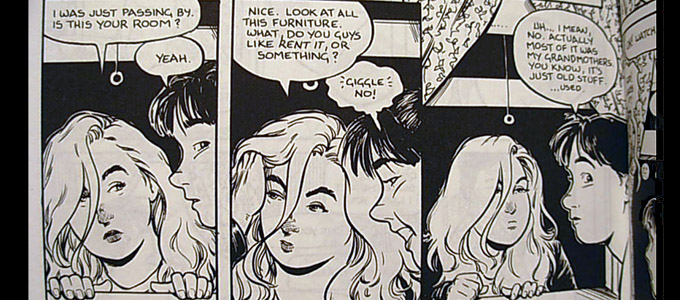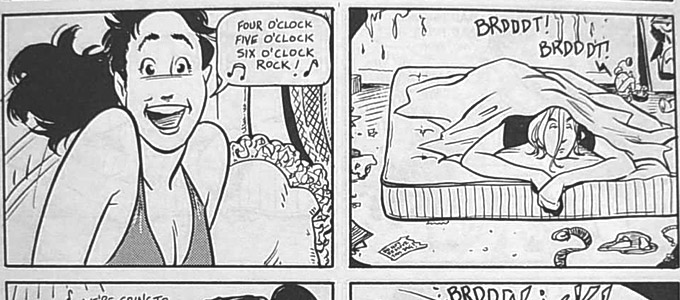This page may contain one or more affiliate links, which means that if you purchase a product through that link, I may receive compensation. The links will be identified with the text "affiliate link". Click to learn more.
You see, volume 3 of Strangers in Paradise was pretty bad, awful even at times. It was even said so in the comment section in the back of one of the comics, many people saying they cancelled their subscription. However, there were a few sparkling gems.
In Strangers in Paradise issue 13, volume 3, the comic book takes a nostalgic turn as it delves into the high school days of the main characters, Francine and Katchoo. The flashback offers a glimpse into the duo’s past, revealing pivotal moments that shaped the foundation of their unique friendship. As the characters navigate the challenges of adolescence, their experiences, both comical and heartwarming, come to life on the pages. This retrospective storyline, filled with unexpected twists and turns, provides a captivating exploration of the bonds that tie these characters together.
Francine, with her strong sense of loyalty and unwavering support, and Katchoo, with her fierce independence and artistic spirit, form an unbreakable bond despite the social hierarchies and pressures of high school. As the personal trials and triumphs of their youth intertwine, readers begin to understand how the intricacies of their past have shaped the powerful friendship we see in their present-day lives.
This issue shows how Katina and the fat chick, what’s her name? Francine. This story shows how Francine and Katchoo met. It also shows a familiar scene from Strangers in Paradise issue 1 volume 1. What makes this issue so great is shown on the first page. Francine wakes up gitty to a loving family, and Katchoo wakes up on a dirty mattress lying on a bare floor, and a family member is yelling at her. I love this page. I might go as far as saying it’s among the best pages in volume 3, except for the first few and last few. Skip the other garbage in volume 3 and pick up (Affiliate Link) this issue.

Appeal of Strangers in Paradise
The relatability of Strangers in Paradise is one of its main drawing factors. In the series, we are introduced to Francine, Katchoo, and David – three protagonists – whose journeys revolve around the complications of love, friendship, and self-improvement. They are not portrayed as ideal characters because of their mistakes, mishaps, and personality imperfections; however, this makes them real, thus helping readers to associate with them easily. The series exposes the possible resolutions for many actual life situations, which is why it’s engaging and captivating.
Right from its inception, the series has addressed issues pertaining to sexuality and gender identity in a manner that is not only genuine but also considerate. Combining drama and comedy skills together, Moore has given us an emotional story mixed with questions and doubts which are almost heartwarming at the same time. No matter what their own sexual preference may be, the characters’ quests towards accepting themselves and discovering love are universal experiences shared by many readers.
But the show doesn’t shy away from the messiness of human relationships, either. It’s true that Francine, Katchoo, and David form a love triangle, which is essentially all about these three people and what they feel about one another but no less in an effective way. Moore goes further to describe how different characters respond to their emotions given their intrinsic differences. That way it feels real and deepens the story into something more than a regular love triangle.
Strangers in Paradise deserves attention not only because it is relatable and tackles serious problems, but also because of its artwork that adds more color to the comic story. The author has paid attention to every detail and put a lot of effort into the design of each character, which made them really vivid on the pages. The use of monochrome images creates another special feature that distinguishes the series, while facial expressions and body language allow us to feel the emotions they experience with extra force.
The Realism of Francine and Katchoo
Terry Moore, the cartoonist known for his drawing style, has made a name for himself by presenting females in a very realistic manner. The comic book business is renowned for its ability to overemphasize and objectify women in a highly sexualized form; however, Moore has deliberately resolved to show their natural and familiar faces. One clear example of this is found in his successful series called ‘Strangers in Paradise,’ which features two female lead characters—Katchoo and Francine.
Gender equality is the first thing we notice in Moore’s work because his female characters are very diverse. He does not focus on a particular body structure or beauty canon but invents women with all sorts of shapes and sizes as well as facial traits.
Strangers in Paradise is a lengthy comic series that is about two prominent female figures, namely Katchoo and Francine. Katchoo is a slender, flat-chested, sharp-featured, light-haired woman known as Katina Choovanski. Unlike Katchoo, Francine has a curvy body figure with little weight gain and flowing dark hair. They are depicted as beautiful in their own way, differing from the standards of beauty usually imposed by comics.
Another feature that impresses me is the obsession Moore has with detail that allows him to delineate a female character’s emotions without ever using dialogue. He takes great care of body language, mimicry, and even details like the way the hair falls. This puts his female characters into focus as living people with their unique inner world, and not only objects in an environment filled with male perspectives.
It is true that Moore’s interest in portraying women realistically was not lost on his audience. Most of them have commended him on how he manages to give visual appeal, but also characters that are real and not easy to forget. In a world where women are often treated as objects or stereotyped as flat characters in comics, Moore offers us an exception.

